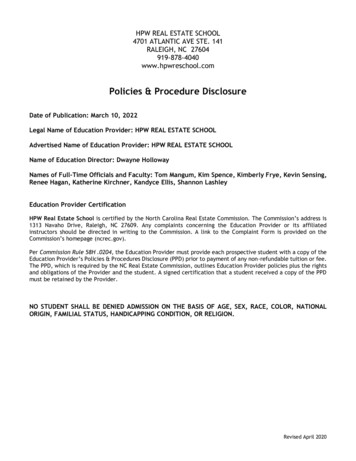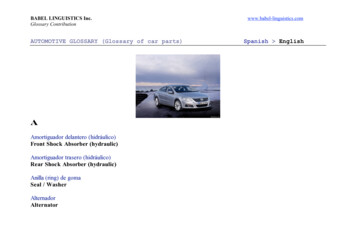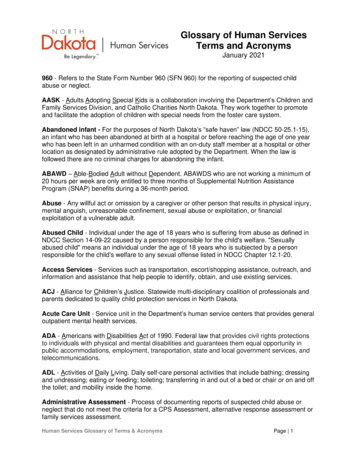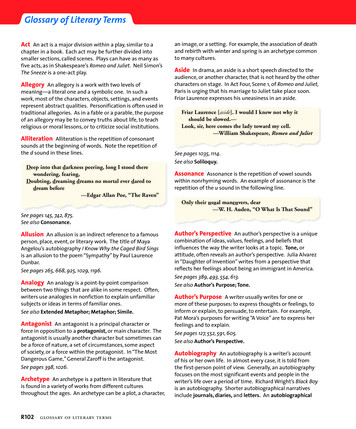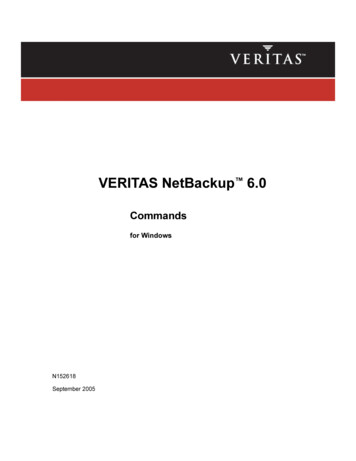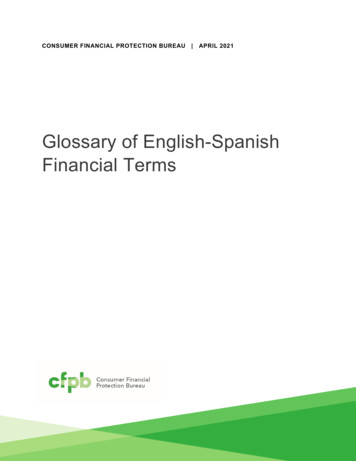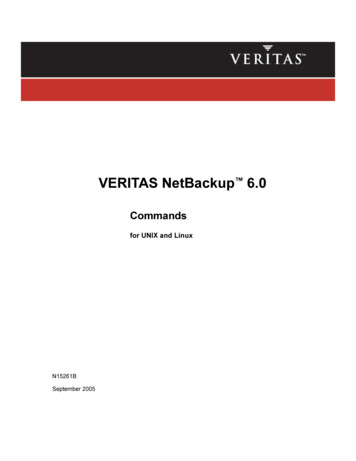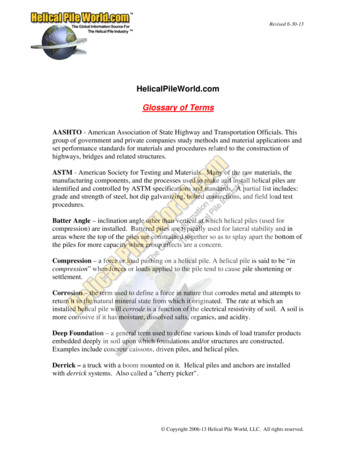
Transcription
Revised 6-30-13HelicalPileWorld.comGlossary of TermsAASHTO - American Association of State Highway and Transportation Officials. Thisgroup of government and private companies study methods and material applications andset performance standards for materials and procedures related to the construction ofhighways, bridges and related structures.ASTM - American Society for Testing and Materials. Many of the raw materials, themanufacturing components, and the processes used to make and install helical piles areidentified and controlled by ASTM specifications and standards. A partial list includes:grade and strength of steel, hot dip galvanizing, bolted connections, and field load testprocedures.Batter Angle – inclination angle other than vertical at which helical piles (used forcompression) are installed. Battered piles are typically used for lateral stability and inareas where the top of the piles are constrained together so as to splay apart the bottom ofthe piles for more capacity when group effects are a concern.Compression – a force or load pushing on a helical pile. A helical pile is said to be “incompression” when forces or loads applied to the pile tend to cause pile shortening orsettlement.Corrosion – the term used to define a force in nature that corrodes metal and attempts toreturn it to the natural mineral state from which it originated. The rate at which aninstalled helical pile will corrode is a function of the electrical resistivity of soil. A soil ismore corrosive if it has moisture, dissolved salts, organics, and acidity.Deep Foundation – a general term used to define various kinds of load transfer productsembedded deeply in soil upon which foundations and/or structures are constructed.Examples include concrete caissons, driven piles, and helical piles.Derrick – a truck with a boom mounted on it. Helical piles and anchors are installedwith derrick systems. Also called a "cherry picker". Copyright 2006-13 Helical Pile World, LLC. All rights reserved.
Revised 6-30-13Down Drag – the phenomenon where soft soils surrounding a helical pile consolidateand produce a downward force on the pile tending to cause additional settlement.Consolidation can be triggered by soil self weight, periodic changes in ground water,placement of fill, or other surcharge loads on the ground surface.Extension – helical extensions are the square bar or round shaft sections that getconnected one after another to the helical lead section as required to form a continuouscolumn of steel in the ground – an installed helical pile. Extensions too can have helicalblades or bearing plates welded to the central shaft, which is often required in very softsoils or in soil nail applications.Factor of Safety – a mathematical calculation used by engineers to develop a margin ofsafety when calculating capacities. With respect to helical piles, the most commonlyspecified factor of safety is 2.0. If a helical pile has a 100 KIP ultimate capacity, thenapplying a factor of safety of 2 would result in a working capacity of 50 KIPS.FHWA - Federal Highway Administration. This is a division within the federalgovernment that regulates and controls all aspects of federal highway construction,inspection and oversight.Foot Pounds – the English unit of measure for measuring moment, torque, or torsionalforce; in the Metric system, torque is measured in Newton-meters. Helical piles arerotated into the ground with a torque (or gear) motor and the final measure of foot poundsof torque correlates to the axial compression or tensile capacity of the installed helicalpile. See also Moment.Foundation – typically a sub-structure made of concrete, block, steel or other substancesbuilt into or on top of soil. The purpose of a foundation is to transfer the load of a superstructure to the soil for the purpose of stabilization and to prevent settlement and potentialfailure of structural integrity.Full Scale Load Test – term used to define a procedure to determine the field capacity ofa full-size helical pile in compression (e.g. ASTM D1143), tension (ASTM D3689), orboth.Group Effects – generally refers to the case where a group of helical piles has a lowercapacity than the sum of individuals. This can occur when helical piles, or any deepfoundation for that matter, are spaced to close together. Copyright 2006-13 Helical Pile World, LLC. All rights reserved.
Revised 6-30-13Helical Blade – Often referred to as a bearing plate – is formed in the shape of a helixand is welded to the central shaft of a helical lead section or a helical extension section.The most common sizes, but not all, of helical blades range from 8” to 14” in diameter.When embedded in firm soil, helical blades have bearing capacity for supportingcompressive or tensile loads. When multiple helical blades are welded to a shaft, theblades are spaced in such a way so they track or follow one another through the soil tominimize soil disturbance.Helical Pile – A foundation element consisting of a central shaft with at least one helixplate located on the shaft with its axis positioned parallel to the shaft’s length.Also referred to as a Helix Pier, Helical Pile, Helical Anchor, Screw Anchor, Screw Pile,Helical Pier, or simply HelicalHelical piles can be used as anchors to withstand tensile loads or as deep foundations towithstand compressive loads or both simultaneously. The terms helical pile, helix pier,helical pier, and screw pile are generally used when the device is to be used incompression. The terms helical anchor or screw anchor are generally used when theelement is to be used in tension.Hot Dip Galvanizing – the process of dipping a helical pile lead or extension into moltenzinc to form a protective coating. A helical pile that has been hot dip galvanized hassignificantly improved protection against the forces of corrosion when compared to baremetal once the helical pile has been installed.ICC – The International Code Council, a membership association dedicated to buildingsafety and fire prevention, develops the codes used to construct residential andcommercial buildings, including homes and schools. Most U.S. cities, counties and statesthat adopt codes choose the International Codes developed by the International CodeCouncil.ICC-ES – International Code Council Evaluation Services is a nonprofit, public-benefitcorporation that does technical evaluations of building products, components, method,and materials. ICC-ES came into being on February 1, 2003, when America's fourbuilding-product evaluation services officially combined their operations. The four"legacy" evaluation services that came together to form ICC-ES were the NationalEvaluation Service, Inc.; BOCAI Evaluation Services; ICBO Evaluation Service, Inc.;and SBCCI Public Service Testing and Evaluation Services, Inc. Through the legacyevaluation services, ICC-ES has a history that goes back more than seventy years. Copyright 2006-13 Helical Pile World, LLC. All rights reserved.
Revised 6-30-13In situ (Soil) – the undisturbed or original soil at a construction site.KIP – an industry designation for Kilo-pounds (1000 pounds). Engineers often specifyin KIPS the design or working load that a helical pile must support. For example: 50KIP Design Load equals 50,000 pounds.Lateral Load – a force or load pushing or pulling on a helical pile where the force isacting in a direction that is transverse (perpendicular) to the longitudinal axis of a pile.Lead or Lead Section – the first section of a helical pile is called the lead, and the leadalways has one or more helical blades or bearing plates welded to the square bar or roundpipe central shaft. Leads can be almost any length depending upon the project for whichthey are being installed. Typically, Leads are between 5 and 10 feet in length.Load Frame – one of the parts or components used to conduct a full scale load test. Aload frame is a custom designed configuration of structural steel members and othercomponents configured in such a way to work in conjunction with a hydraulic pressuresource with the objective being to apply a specified load or force (compression ortension) to one or more helical piles.LRD – an acronym for Lateral Resistance Device. With respect to helical piles, it is aloosely defined term for a typical helical pile lead section with blades connected to largerdiameter extension sections. For example, a 1.5” square bar lead section might have 1 ormore 6” diameter round shaft extensions connected to it via a tapered or graduatedconnector system. Since the termination end of the pile is 6” in diameter, it has a higherlateral resistance capacity than if 1.5” square bar extensions were used to termination.LRFD – an acronym for Load and Resistance Factor Design, which means both appliedservice loads and the capacity of a helical pile have a factor of safety applied.Lifting Bracket – also referred to as foundation bracket or underpinning bracket, is aname given to a product used by foundation repair contractors to connect a helical pile toa foundation wall or footing. It is also used to form an underpinning system for liftingsettled foundations or walls.Moment – In theory, it is the same as torque. Although, moment is generally used foroverturning (as in the case of wind tipping something over) and torque is used forrotation about the longitudinal axis of the helical shaft. Both are measured by taking theforce required to turn something times the distance the force acts from the point of Copyright 2006-13 Helical Pile World, LLC. All rights reserved.
Revised 6-30-13rotation. Hence, 100 pounds applied to a 1 foot wrench equals 100 foot-pounds. Thesame force applied using a 2 foot wrench equals 200 foot-pounds.Mooring – with reference to a helical pile, a marine anchoring system utilizing a helicalpile embedded into the soil beneath a body of water with a line made of chain, cable orother material hooked to a floating buoy, to which a boat or other floating vessel istethered.NEMA - National Electrical Manufacturers Association, which sets the standards formanufacturers of electrical utility-type products.Overturning or Overturning Moment – a term generally used when discussing wind orother lateral loads applied to the top of a pile that tend to cause a helical pile to exhibittranslation (tip it over). See also Moment.PAPI and NAVID - FAA (Federal Aviation Administration) acronyms for landing andnavigational control systems.Pile Cap – a term used to define a terminator or connection mechanism for connectingthe top end of a helical pile to another object for the purpose of transferring a load orforce. Examples include grade beam pile caps, wall caps, tieback caps, guy wire caps,etc.Pile – In the building codes, the term pile refers to a foundation with a depth greater thanten times the diameter. Foundations not meeting this criterion are called piles. In sometextbooks, a pier is a foundation element that extends above ground some distance,whereas a pile is fully embedded in the ground. In the Western United States, the termpier is used to mean a drilled foundation and a pile is a driven foundation. In the EasternUnited States, the term pile is used generically to represent any deep foundation.Powder Coating – a process that causes a resin powder to adhere (kind of an advancedpaint) to a helical pile using spraying, electrostatics, heating, and curing.Refusal – with respect to helical piles, it can mean rotation without forward advancementor achieving maximum installation torque.Resistance Bar – also referred to as a Torsion Bar; used as a counter resistance to thetorsional force of a portable, hand-operated, free-standing torque motor during helicalpile installation. The resistance bar is attached to a torque motor at one end, and the Copyright 2006-13 Helical Pile World, LLC. All rights reserved.
Revised 6-30-13other end is braced against an immovable structure, thus serving as a counter force orresistance for the torque motor.Resistivity or Soil Resistivity – is the opposite of electrical conductivity. Soil isgenerally given a resistivity rating, which is expressed in ohm-cm. A resistivity rating isthen used to calculate the rate at which a helical pile will corrode – taking intoconsideration the thickness of the steel and any corrosion protection that has beenapplied.SBCCI - The Southern Building Code Congress International also called the StandardBuilding Code. This group sets the minimum building codes for the southeast section ofthe USA from the Mississippi River east and north to the 36.5 degree parallel. Somestates, Arkansas, Delaware, Indiana, Texas, and West Virginia, have two codes ordifferent codes. Not all counties or municipals adopt building codes.Shear – with respect to a helical pile, it is basically the same as lateral load or transverseload. In structural engineering and mechanics, it is a force acting on a plane in that plane.A good example of a shear failure is caused by scissors or shears.Slender Shaft Pile – a term sometimes used to define deep foundation piles with a shaftdiameter or 6” or less. Most, but not all, helical piles installed around the world today areslender shaft piles except for light pole bases and the like.Slide – a device that (usually) attaches to the boom of an excavator. The slide is used tohold and control the forward and backward movements of a torque motor during theprocess of installing a helical pile – usually in horizontal applications like tiebacks andretaining walls.Soil Nail – another term for helical anchors when multiple anchors with multiple bladesare being used to stabilize soils on a hillside or slope. Soil nails are also used to constructretaining walls. In a soil nail application, all extension sections, as well as the leadsection, are configured with helix blades or bearing plates – typically all with the samediameter. The helical blades along the upper length of shaft resist movement of the soilswithin the active zone and the deeper helical blades prevent movement of the helicalshaft.SPT – Acronym for Standard Penetration Test; a commonly used soil density test. Asplit spoon sampler is hammered into the ground using a controlled weight and distancedevice. Each impact of the weight is called a “blow”, and the number of blows required Copyright 2006-13 Helical Pile World, LLC. All rights reserved.
Revised 6-30-13to move the split spoon sampler 12” in depth is called the “blow count”. Engineers whospecify helical piles and contractors who install them refer to “blow counts” whendetermining the blade configurations for helical pile projects.Tension Load – often referred to as Tensile Load, it is a force or load pulling on a helicalpile. A helical pile is said to be “in tension”, when forces or loads applied to the pile tendto cause pile lengthening or pull-out. Forces that produce tension loads are wind,expansive soil, water buoyancy, frost, and earthquakes.Torque – force x moment arm torque; or the force applied to a helical pile by a gearmotor that causes the pile to rotate and advance into the soil. See also Moment. Copyright 2006-13 Helical Pile World, LLC. All rights reserved.
a full-size helical pile in compression (e.g. ASTM D1143), tension (ASTM D3689), or both. Group Effects - generally refers to the case where a group of helical piles has a lower capacity than the sum of individuals. This can occur when helical piles, or any deep foundation for that matter, are spaced to close together.
